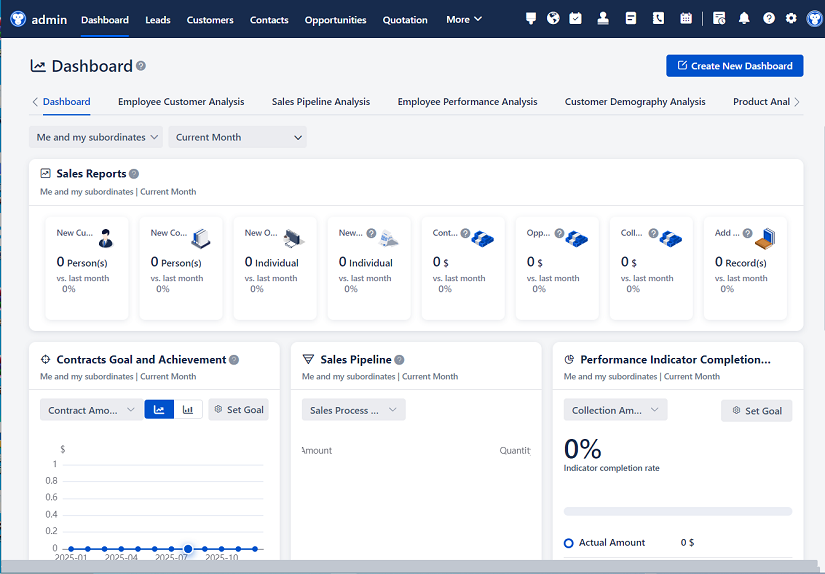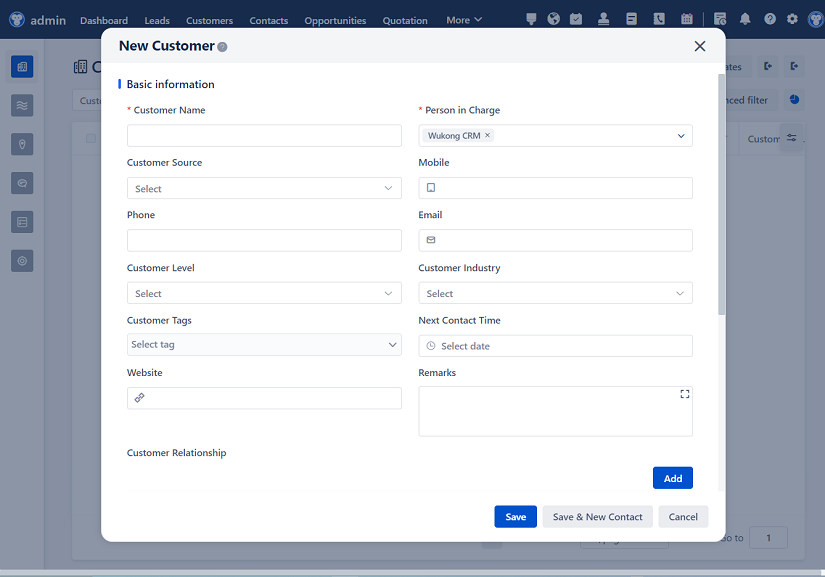
△Click on the top right corner to try Wukong CRM for free
So, you know, I’ve been thinking a lot lately about how businesses actually use CRM systems in the real world—not just the theory, but the messy, complicated, sometimes frustrating reality of it. I mean, we all hear about Salesforce or HubSpot or Microsoft Dynamics, right? They sound great on paper—automated workflows, customer insights, sales pipelines—but what really happens when a company actually rolls one out?
Well, let me tell you about a mid-sized retail company I came across recently. They had been using spreadsheets and email to manage customer interactions for years. Sounds familiar, doesn’t it? Honestly, so many small and medium businesses are still doing that. Anyway, they decided it was time to grow, and they knew they needed something better. So they invested in a CRM—specifically, HubSpot, because it was user-friendly and didn’t break the bank.
Free use of CRM system: Free CRM
At first, everyone was excited. The sales team thought, “Great, now I won’t lose track of leads!” The marketing team said, “Finally, we can segment our audience properly!” And the customer service team was like, “Maybe now we can actually see a customer’s history before we pick up the phone.” But then… reality hit.
You see, just buying a CRM doesn’t magically fix everything. They had to migrate years of messy data—names spelled wrong, duplicate entries, outdated emails. It was a nightmare. I remember talking to their IT manager, and he said, “We spent more time cleaning data than setting up the actual system.” And honestly? That’s super common. A lot of people don’t realize how crucial clean data is until they’re knee-deep in it.

But here’s the thing—they didn’t give up. They brought in a consultant to help with the setup, trained their teams, and slowly started using the CRM for real tasks. Sales reps began logging calls and setting follow-up reminders. Marketing started running targeted email campaigns based on customer behavior. And customer service could finally see a full history of interactions.
After about six months, they started seeing results. Response times improved. Sales conversion rates went up by 18%. Customer satisfaction scores climbed. Was it perfect? No. Some people still resisted using it, and there were glitches. But overall, it was working.
Now, contrast that with another company—a B2B software firm I heard about. They went all-in on Salesforce, spent a ton of money, and expected instant transformation. But guess what? They didn’t train their team properly. The salespeople found it clunky and time-consuming. Managers weren’t enforcing usage. So after a year, they were still relying on Outlook and sticky notes.

I asked one of their sales reps why they weren’t using the CRM, and he said, “Because it doesn’t save me time—it adds more steps.” That hit me hard. It’s a classic case of technology being ahead of the people using it. You can have the most advanced CRM in the world, but if your team doesn’t adopt it, it’s just expensive software sitting on a server.
So what’s the difference between the companies that succeed and those that fail? From what I’ve seen, it’s not about the brand of CRM. It’s about culture, training, and leadership. The retail company I mentioned earlier had a manager who championed the CRM, held weekly check-ins, celebrated wins, and addressed concerns. The software firm? Leadership assumed the tool would fix everything without their involvement.
Another interesting case I came across was a nonprofit organization. They used Zoho CRM to manage donor relationships. At first, they were skeptical—“We’re not a sales team, why do we need a CRM?” But then they realized donors are like customers. They have preferences, histories, and communication patterns.
They started tracking donation history, event attendance, and personal interests. When a donor called, staff could say, “Hi Sarah, I see you attended our gala last year and supported the education program—would you like info on this year’s initiative?” That personal touch made a huge difference. Donor retention increased by 25% in one year.
It just goes to show that CRM isn’t just for sales teams. Any organization that interacts with people can benefit. Even schools are starting to use CRM systems to track student engagement and parent communication.
But let’s talk about the challenges, because they’re real. One big issue is integration. A lot of companies use multiple tools—email, accounting software, project management apps—and if the CRM doesn’t talk to them, it becomes a silo. I’ve seen teams enter the same data in three different places. That’s not only inefficient, it leads to errors.
Another challenge is customization. Off-the-shelf CRMs are great, but every business is different. The retail company I mentioned had to tweak HubSpot to handle their unique product categories and customer journey. That took time and some technical know-how. But once it was set up right, it became a powerful tool.
Security is another concern. CRMs hold a ton of sensitive data—names, emails, purchase history, even notes about personal conversations. If that gets hacked, it’s a disaster. So companies need to think about permissions, encryption, and backups. I’ve seen cases where employees left the company but still had access to the CRM. That’s a huge risk.
And then there’s the cost. Sure, some CRMs have free tiers, but once you need more features, users, or integrations, the price goes up fast. One small business owner told me, “I didn’t realize how quickly the per-user fee would add up.” So budgeting is important. You don’t want to end up paying for features you’re not even using.
But when it works? Oh man, it’s beautiful. Imagine a sales rep walking into a meeting and pulling up a complete profile of the client—their past purchases, recent support tickets, even their LinkedIn activity. That’s powerful. Or a customer service agent resolving an issue in one call because they can see the full history. That’s customer experience done right.
I also think mobile access is a game-changer. So many sales and service teams are on the go. Being able to update the CRM from a phone or tablet means real-time data entry. No more “I’ll do it later” and then forgetting. One field service company told me their technicians use the CRM app to log job details right after a visit. That improved reporting accuracy by 40%.
Analytics is another underrated feature. Most CRMs come with dashboards and reports. But a lot of companies don’t use them. They set up the system, enter data, but never look at the insights. That’s like buying a car and never checking the speedometer. One company started reviewing their CRM reports monthly and discovered that 70% of their high-value customers came from one specific marketing channel. So they shifted their budget—and revenue jumped.
Change management is probably the hardest part. People resist new tools. They’re comfortable with the old way, even if it’s inefficient. So training has to be ongoing, not just a one-time session. And leadership has to model the behavior. If the CEO isn’t using the CRM, why should anyone else?
One company I know made CRM usage part of performance reviews. Not in a punitive way, but as a positive metric. “How well do you maintain customer records?” “Are you using the system to track opportunities?” That helped create accountability.

And let’s not forget about customer consent and privacy. With GDPR and other regulations, you can’t just collect data willy-nilly. Customers need to know what you’re collecting and why. The best companies use their CRM to respect privacy—tagging opt-ins, setting communication preferences, and making it easy to unsubscribe.
So, what’s the bottom line? CRM systems can be incredibly powerful, but they’re not magic. Success depends on people, process, and planning. You need to choose the right tool for your needs, clean your data, train your team, integrate with other systems, and use the insights wisely.
And honestly? It’s a journey. You won’t get it perfect on day one. There will be hiccups. But if you stay committed and keep improving, the payoff is huge—better relationships, smarter decisions, and real business growth.
From everything I’ve seen and heard, the companies that treat CRM as a strategic tool—not just a software purchase—are the ones that win.
FAQs (Frequently Asked Questions)
Q: Do small businesses really need a CRM?
A: Honestly, yes—if they care about customer relationships. Even a simple CRM can help track leads, follow-ups, and customer history. It’s not just for big corporations.
Q: How long does it usually take to see results after implementing a CRM?
A: It varies, but most companies start seeing improvements in 3 to 6 months. The key is consistent usage and data quality.
Q: What’s the biggest mistake companies make with CRM?
A: Probably assuming the software will fix everything on its own. Without training, leadership support, and process changes, even the best CRM will fail.
Q: Can CRM systems help with customer retention?
A: Absolutely. By tracking interactions and preferences, you can personalize communication and anticipate needs—both of which keep customers coming back.
Q: Is it better to go with a cloud-based CRM or an on-premise one?
A: For most businesses today, cloud-based is easier and more cost-effective. It’s scalable, accessible from anywhere, and usually includes automatic updates.

Q: How do I get my team to actually use the CRM?
A: Start with clear communication about why it matters. Provide hands-on training, make it part of daily routines, and have leaders use it too. Show the benefits—like saving time or closing more deals.
Q: Can CRM data be used for marketing automation?
A: Definitely. Most modern CRMs integrate with email marketing tools and can trigger personalized campaigns based on customer behavior.
Q: What should I look for when choosing a CRM?
A: Think about your specific needs—number of users, industry, integration requirements, budget. Try demos, read reviews, and don’t forget to consider ease of use. A powerful CRM is useless if no one wants to use it.
Related links:
Free trial of CRM
Understand CRM software

△Click on the top right corner to try Wukong CRM for free